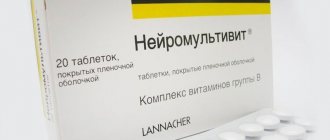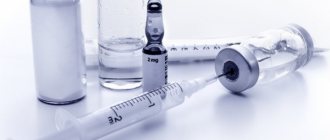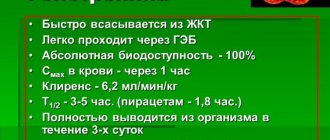Suprastin is classified as a first generation antihistamine. Despite the fact that the pharmaceutical industry today presents many of its safer analogues, it is still popular. Moreover, it is also used in pediatrics, prescribing Suprastin to children to relieve allergic manifestations and prevent their dangerous complications.
Composition and release forms of the drug for children
The active substance that provides the therapeutic effect of the drug is chloropyramine hydrochloride. Depending on the form of the product, it is supplemented with various substances. Suprastin tablets, in addition to the main component, contain:
- stearic acid;
- potato starch granules;
- lactose monohydrate;
- gelatin compounds;
- carboxymethyl starch Na group A.
The tablets are white or grayish in color, separated by a score in the middle, and also have an engraving with the international name. They are sealed in blisters placed in cardboard packages. There can be 1 or 2 of them in one box.
Suprastin is also produced as a solution for intramuscular administration. The main substance and water for injection are present here. It is an almost colorless liquid with a very faint specific odor. It is poured into tinted glass containers, screwed on with plastic lids. Ampoules are packaged in cardboard boxes of 20 pieces. There are no other forms of the drug.
The medicine retains its medicinal properties for 5 years from the date of release. It should be stored in a room with a temperature of 15 to 25 degrees, and protected from exposure to sunlight. If the medicinal composition in tablet form can be purchased at a pharmacy completely freely, then when purchasing Suprastin injections you will need to present a doctor's prescription.
Pharmacological action, pharmacodynamics and pharmacokinetics
The medicinal composition has a pronounced antiallergic and antihistamine effect. It is also capable of providing antiemetic and moderate antispasmodic effects. After the drug enters the body, its absorption occurs quite quickly, it is rapidly distributed in the cells. Relief occurs after a quarter of an hour.
The active substance is almost completely absorbed from the digestive tract, and reaches its maximum concentration in the blood after approximately 60 minutes. The effect of application lasts from 3.5 to 6-7 hours. Chloropyramine hydrochloride is metabolized by the liver and excreted by the kidneys. It is noteworthy that in a child’s body this process proceeds somewhat faster than in adults.
Why is Suprastin prescribed to children?
According to the instructions for use, Suprastin is allowed to be prescribed to a child for the following conditions:
- allergies to foods or medications;
- serum sickness;
- allergic rhinitis;
- conjunctivitis of various origins;
- hives;
- skin itching of any etiology;
- dermatological problems;
- eczema of acute and chronic forms;
- acute reaction to insect bites;
- Quincke's edema.
This is an allergy medicine for children and is prescribed before the Mantoux or Diaskintest test in case of high sensitivity to the components of the vaccine.
Instructions for use and dosage for a child
In each case, the doctor prescribes an individual dosage of the medicine. The annotation for the medicine describes only common patterns of its use.
Suprastin tablets. The daily volume of the medicinal composition is prescribed depending on the age of the patient. For infants, it will be a fourth or fifth of a tablet twice a day. Patients under 6 years of age are prescribed one tablet per day, which must be divided into two doses. From 6 to 14 years old Suprastin is taken 1-1.5 tablets two to three times a day. In this case, you can take no more than 1/2 part at a time. The maximum daily dose for children is 2 mg of medication per 1 kg of weight.
Solution in ampoules for injections. Suprastin solution is intended for intramuscular injections, but in special cases it can also be administered intravenously. As a rule, this is done in the initial stages of therapy. The dosage for different age categories is as follows:
- babies up to one year - 0.25 ml;
- from 12 months to 6 years - 0.5 ml;
- from 6 to 14 years - 0.5-1 ml.
As when using the tablet form, the permitted volume of solution per day is no more than 2 mg per 1 kg of patient weight. Suprastin in the form of tablets or injections is not prescribed to newborns.
Drug interactions
Chloropyramine hydrochloride is classified as a potent compound that can enter into strong chemical reactions with other components. Therefore, there are a number of restrictions for the combination of Suprastin with other drugs. This medication enhances the effects of the following groups of medications:
- analgesic compounds;
- atropines;
- sympatholytics;
- tranquilizers;
- MAO inhibitors;
- sedatives.
When there is a need for joint therapy, it takes place only under strict medical supervision.
Contraindications, side effects and overdose
The main contraindications to the use of Suprastin include the following conditions:
- high susceptibility to the components of the drug;
- lactose imbalance in the body or lactose intolerance;
- bronchial asthma during acute attacks;
- age up to 3 years (for tablets);
- infancy (for all forms).
Caution is required if the patient has been diagnosed with the following conditions:
- angle-closure glaucoma;
- disorders of the liver and kidneys;
- dysfunction of the cardiovascular system;
- urinary tract diseases.
The composition provokes side symptoms extremely rarely; they often go away on their own after its discontinuation.
Undesirable manifestations include:
- urinary disorders;
- loss of clarity of vision;
- decreased muscle tone;
- diarrhea and constipation;
- nausea and vomiting;
- appetite disorders;
- pain in the stomach;
- pressure surges;
- disturbances in heart rhythm;
- increased intraocular pressure;
- constant feeling of fatigue;
- dizziness and trembling of limbs;
- headache;
- convulsive manifestations;
- changes in blood composition;
- various allergic manifestations.
As a result of exceeding the recommended dosage, the following symptoms appear:
- the child becomes restless, excited and overly anxious;
- coordination of movements and perception are impaired, hallucinations are possible;
- there is dilation of the pupils, redness of the skin on the face;
- the patient's heart rate increases, fever and convulsions occur quite often;
- urinary disorders are common;
- in especially severe cases, coma occurs.
In such situations, it is indicated to rinse the stomach, followed by the use of sorbents and symptomatic therapy.
Allergy drug analogues
Today, pharmacies offer many medicines that have properties similar to Suprastin. If the latter is contraindicated, it is replaced with Fenistil, Tavegil, Zyrtec, Claritin, Diazolin or Diphenhydramine. Since all these drugs differ in the degree of effectiveness and are based on different substances, the choice of medicinal composition remains with the specialist. Unauthorized prescription of any medication can lead to dangerous consequences.
Tags: allergies, medications, medications for children, medications, Suprastin, medications, medications for children, use of Suprastin, allergy medications, Suprastin, Suprastin for children
- Related Posts
- Which cough drops should a child choose?
- Demodicosis of the eyelids - symptoms and signs
- Medicines and folk remedies for children
« Previous entry
General information about the drug
Suprastin is an antihistamine. Despite the fact that it does not have many competitors, it still remains the most popular. The drug does an excellent job of relieving allergy symptoms.
Just like any other, it has various side effects and contraindications. Parents should pay attention to this when purchasing the drug in order to prevent unwanted consequences in the child.
Release form, composition and packaging
Suprastin contains a substance - chloropyramine hydrochloride. It is a blocker of allergic reactions and also significantly reduces their occurrence. The composition also includes auxiliary substances. For example, stearic acid, lactose monohydrate and others.
There are two forms of release of Suprastin for children:
- Tablets 25 mg. The tablets are round in shape and contain an inscription indicating the name of the medicine.
- Ampoules , injection solution 20 mg/l. The liquid in the ampoules is not colored in any way, but has a distinct odor. This form of release is used for anaphylactic shock, administering the drug intravenously or intramuscularly.
Pharmacokinetics
Pharmacokinetics of Suprastin for children:
- Suction . After taking the tablets, the active substance is quickly absorbed from the gastrointestinal tract into the blood plasma. This happens in the first hours of admission.
- Distribution . It is well distributed throughout the body, regardless of the type of medication taken.
- Metabolism . Suprastin is metabolized in the liver.
- Removal . It occurs much faster in children and is excreted in the urine.
Indications
Suprastin is required if certain types of diseases appear in children. A doctor can prescribe the medicine.
Diseases for which there is a need for a drug for children:
- allergies to mosquito bites and other insect bites;
- angioedema;
- nettle rash;
- seasonal runny nose;
- the presence of very severe itching during chickenpox;
- allergic reaction to pollen;
- allergies to medications or food products;
- allergic cough;
- conjunctivitis;
- serum sickness;
- swelling of the mucous membranes of the nose and bronchi;
- skin diseases;
- ARVI.
Indications for use
Traditional first generation medicines have a number of advantages. Chloropyramine-based drugs interfere with the action of histamine on H1 receptors, which are located in parts of the peripheral and central nervous system.
They do not affect the natural synthesis and release of mediators of immediate allergic reactions, block alpha-adrenergic receptors and m-cholinergic receptors, and have a local anesthetic effect.
But in order to exclude the negative effect of Suprastin on the body, it is necessary to carefully read the main indications for the use of the antiallergic drug. It is prescribed for dermatitis, urticaria, rhinitis, eczema, Quincke's edema, serum sickness, conjunctivitis, itching and allergies of various etiologies.
Only under medical supervision and if there is a risk to life, it is recommended for people with heart disease, kidney and liver failure. Prescribed to patients with prostatic hyperplasia, urinary retention, angle-closure glaucoma, and representatives of the older generation.
Contraindications
The drug can be taken by children aged 1 month, but only in the form of a solution. The tablets are contraindicated in children under three years of age. The medication is taken under the supervision of a doctor.
Contraindications are the presence of the following diseases or factors:
- prematurity and, as a consequence, weakening of the body;
- presence of bronchial asthma with acute attacks;
- intolerance to substances included in the drug. This is especially true for lactose;
- problems with the urinary system;
- presence of kidney and liver diseases.
Also, in the case of treatment with the drug to a mother who is breastfeeding, it is necessary to stop breastfeeding to prevent substances from reaching the baby through milk.
This is due to the fact that the use of the product is contraindicated for newborn babies. If breastfeeding cannot be stopped, it is better to prescribe another drug.
Contraindications to the use of Suprastin
The therapeutic effect of all ethylenediamine derivatives, including the active ingredient chloropyramine, without exception, is aimed at inhibiting the excitation of a large number of mediators, therefore, before taking the drug, it is better to study the existing contraindications of Suprastin:
- premature babies, newborns;
- bronchial asthma;
- pregnancy;
- lactation;
- impaired glucose absorption, galactosemia.
Due to the strong sedative effect of driving and performing hazardous activities that require concentration, you should refrain.
Alcohol is contraindicated in combination with Suprastin. Under the influence of chemicals, the harm of ethyl alcohol and its destructive effect on parts of the brain increases.
Instructions for use
Before you start taking the medicine, you need to study the instructions, since you need to strictly follow the dosage for the baby’s age.
When symptoms appear, do not give more than 2 mg per 1 kg of weight. The course of treatment is a week. The tablets are taken with meals.
The dosage of the drug depends on age. Thus, infants up to one year old can take one quarter of a tablet 2 times a day. The tablet must be crushed and added to formula or breast milk.
Children from 1 to 6 years old can also take one quarter of the tablets, but 3 times a day. At the age of 7 to 14 years, half a tablet is prescribed twice a day. Upon reaching 14 years of age, the child takes tablets in accordance with the adult dosage - 1 tablet three times a day.
When taking an injection solution, there is a different dosage. Newborns and children under 6 years old are given half an ampoule. Children from 6 to 14 years old are prescribed a whole or ½ part of an ampoule. This depends on the severity of the case and is determined by the doctor.
It is worth noting that the injection solution is administered only under the supervision of a physician. This often happens in a hospital. Self-treatment with this type of drug is prohibited.
In ampoules for injections
This form of medicine is used for injections. It is most important to use Suprastin ampoules to relieve a severe allergic reaction, manifested by anaphylactic shock, as well as Quincke's edema.
Initially, the drug is administered intravenously, and after shock is relieved, it is transferred to muscle injections or tablet form, if the patient’s condition improves. The duration of treatment is prescribed by the doctor. The standard dosage of Suprastin for adults is 1-2 ml per day.
For children, it is permissible to use Suprastin in ampoules from the 1st month of life. The norm depends on age: up to 1 year - 0.25 ml; 1-6 years - 0.5 ml; 6-14 years - 0.5-1 ml. But the dosage per day in total calculation should be less than 2 mg per 1 kg of child weight. The solution is administered to the child with an insulin syringe with a long needle.
Suprastin also has a sedative effect, so after taking it you should not drive a car or do work that requires increased concentration.
Overdose
In case of an overdose of Suprastin, the following symptoms appear in children:
- anxiety and excitability increase;
- the mouth feels dry;
- redness appears on the skin.
As soon as you notice such signs, you must immediately stop taking the drug. After which you need to rinse the stomach with activated charcoal.
It is necessary to take the child to the doctor or call an ambulance if the symptoms are very severe.
If the dose of the drug is sufficiently large, coma may occur in young children.
Suprastin drug overdose, symptoms and treatment
Symptoms: in children - agitation, anxiety, hallucinations, ataxia, athetosis, convulsions, mydriasis and immobility of the pupils, flushing of the facial skin, hyperthermia; then - vascular collapse, coma. In adults - lethargy, depression, coma; then - psychomotor agitation, convulsions; rarely - hyperthermia and hyperemia of the skin. Treatment: gastric lavage, use of activated carbon (during detoxification in the early stages of an overdose as a result of oral administration of the drug); according to indications - anticonvulsants, mechanical ventilation and other resuscitation measures.
Adverse reactions
The drug can cause side effects that cause a negative reaction in various organs.
So, side effects may include:
- problems with the urinary system;
- headache;
- trembling fingertips;
- increased lethargy and drowsiness;
- feeling of dry mouth;
- reluctance to eat due to lack of appetite;
- vomiting and nausea;
- diarrhea;
- the appearance of redness, itching and hives;
- strong reaction to sunlight;
- muscle weakness;
- stomach ache.
special instructions
Please note that the tablets contain lactose. The dose contained in the medicine is enough to cause negative effects in children who cannot tolerate it.
It should be used with caution due to the presence of a sedative effect. In this case, it is necessary to exclude activities that require attention and concentration.
Those who have impaired kidney and liver function should take the drug with caution. To do this, you need to reduce the dose of the drug to avoid negative consequences and other complications.
This also applies to those who have diseases associated with the cardiovascular system, as well as glaucoma.
Contraindications, side effects and overdose
Ignoring medication standards causes an overdose. Sometimes this leads to death, especially if it concerns a child.
In this case, the following side effects occur:
- increased nervousness;
- tremor;
- vomit;
- anxiety;
- hallucinations;
- convulsions;
- cardiopalmus;
- urinary retention;
- lack of coordination;
- blurred vision;
- fever;
- increased fatigue;
- drowsiness;
- dizziness;
- convulsions;
- lethargy.
The most dangerous consequences of an overdose are coma and cardiopulmonary collapse, which can cause the death of the patient within 2-12 hours.
There is no special antidote to neutralize unpleasant symptoms. Therefore, the first priority action in case of overdose is to lavage the stomach and take activated charcoal.
Suprastin can also cause side effects, even if all dosage rules are followed in accordance with the patient’s age. If they appear, you must stop therapy and consult your doctor about prescribing another drug with a similar effect.
Most likely side effects:
| Name of organ or system | Characteristic symptoms |
| CNS | Drowsiness, apathy, dizziness, tremor, euphoria, headache |
| The cardiovascular system | Low blood pressure, tachycardia, rapid heartbeat |
| Organs of vision | Glaucoma, a sharp increase in intraocular pressure |
| Circulatory system | Agranulocytosis, hemolytic anemia, leukopenia |
| Musculoskeletal system | Myopathy |
| The immune system | Annoying itching, rashes, urticaria, swelling |
| Urinary system, kidneys | Dysuria, urinary retention |
| Gastrointestinal tract | Abnormal stool, vomiting, lack of appetite, nausea |
Advantages and disadvantages
The drug has its pros and cons, which can be determined from your own experience or from user reviews.
So, the following advantages are highlighted:
- The speed of the effect. The result of the action is noticeable after 15 minutes of taking the drug.
- quite long . It can maintain the effect for up to 6 hours.
The following disadvantages are also highlighted:
- negative side effects of many organs of the child;
- the appearance of drowsiness and lethargy;
- prohibited use for many diseases;
- a larger dose is required to achieve maximum results. Usually it is required to apply it three times in one day.
Analogs
This medicine has many analogues.
Tavegil and Diazolin will help relieve an allergic reaction. The drugs have a similar effect. The advantages and differences from Suprastin include the following factors:
- unlike Suprastin, Tavegil does not cause drowsiness and lethargy, and also continues to act for 12 hours;
- In addition to eliminating allergy symptoms, Diazolin also has an analgesic effect.
However, it is worth noting that these medications are contraindicated for children under one year of age. In this case, Suprastin wins, since its use can be started as early as one month of age.
Drug interactions
Patients taking other medications must discuss their combination with Suprastin with their doctor.
It is not recommended to combine the drug with:
- MAO inhibitors - the duration of the anticholinergic effect increases;
- sedatives, hypnotics, tranquilizers - the risk of side effects increases, and the simultaneous effect of two drugs increases;
- barbiturates - the metabolism of chloropyramine is accelerated, which weakens its therapeutic effect;
- tricyclic antidepressants - have a depressant effect on the central nervous system.
The sedative effect of chloropyramine is neutralized by caffeine and enhanced by clonidine.










